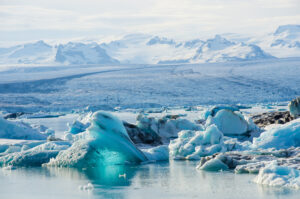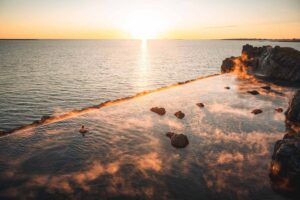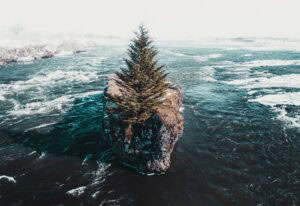There are few places on the planet where you will find an abundance of gorgeous natural attractions so near to the capital city. Iceland is one of these magical places, with a wealth of natural hotspots just a short distance from the capital of Reykjavik. Easy to reach from the main road, it’s no surprise that this is one of the county’s most popular and most visited tourist destinations. Visit Iceland’s splendid South Coast, conveniently next to the Ring Road, and you’ll discover numerous amazing sights, many of which could rightfully be considered natural wonders.
- How to get around the South Coast of Iceland?
- 30 Must-see Attractions and Places on the South Coast of Iceland
- 1. Heiðmörk Nature Reserve
- 2. Hellisheiði Geothermal Power Plant and Exhibition
- 3. Hveragerði Geothermal Park
- 4. Reykjadalur Valley – Hot Springs & Thermal River
- 5. Seljalandsfoss Waterfall
- 6. Gljúfrabúi the “Secret” Waterfall
- 7. Eyjafjallajökull Glacier-Volcano
- 8. Skógafoss Waterfall
- 9. Skógar Museum
- 10. Kvernufoss Waterfall
- 11. Seljavallalaug Pool
- 12. DC-3 Plane Wreck on Solheimasandur Beach
- 13. Dyrhólaey Stone Arch
- 14. Reynisfjara Black Sand Beach
- 15. Vík Village
- 16. Hjörleifshöfði & Yoda Cave
- 17. Fjaðrárgljúfur Canyon
- 18. Eldhraun Lava Field
- 19. Kirkjugólf – The Church Floor
- 20. Foss á Síðu Waterfall
- 21. Dverghamrar (Dwarf Rocks)
- 22. Lómagnúpur
- 23. Skaftafell Nature Reserve
- 24.Svartifoss Waterfall
- 25. Svínafellsjökull Glacier
- 26. Hofskirkja Turf Church
- 27. Vatnajökull Glacier
- 28. Fjallsárlón Glacier Lagoon
- 29. Jökulsárlón Glacier Lagoon
- 30. Diamond Beach
How to get around the South Coast of Iceland?
It’s easy to get to the South Coast from Reykjavik, largely thanks to the Ring Road. “Suðurland”, as the South Coast is known in the Icelandic tongue, boasts the most impressive and dramatic landscapes in the nation. It’s hard to believe that a world of wonder can be so close to the bustling city. As you leave the city streets behind, you’ll notice that the views quickly start to change. As you head closer to the coast, and further from the capital, the scenery becomes more and more spectacular.
The close proximity means that you can hit up the major attractions of the South Coast on a day trip from Reykjavik. It takes about 10 to 12 hours to drive from the capital to Vik, with stops at major beaches and waterfalls. You may spend more or less time, depending on how long you wish to enjoy each attraction.
For even more natural splendour, a day trip of around 14 to 15 hours can include marvellous destinations further towards the east. Add Diamond Beach, Vatnajokull Glacier, and Jokulsarlon Glacier Lagoon to your itinerary for even more majestic sights. It’s only really possible to enjoy all of this on a day trip during the summer months, when the hours of daylight are longer.
It’s perhaps more ideal to break up your trip with an overnight stay along the South Coast. Hvolsvöllur or Höfn are recommended places to stop for the night, allowing you to experience the dramatic landscapes over a couple of days.
With more time you can explore awesome attractions in southern Iceland that aren’t along the coast. The Golden Circle is an incredibly popular sightseeing loop, with famous places like the powerful Gullfoss Waterfall, ethereal geothermal area of Geysir, and majestic Þingvellir National Park.
South Iceland offers a huge variety of activities and tours. There are diverse ways to explore the region, including by rental car, campervan, or as part of a guided tour.
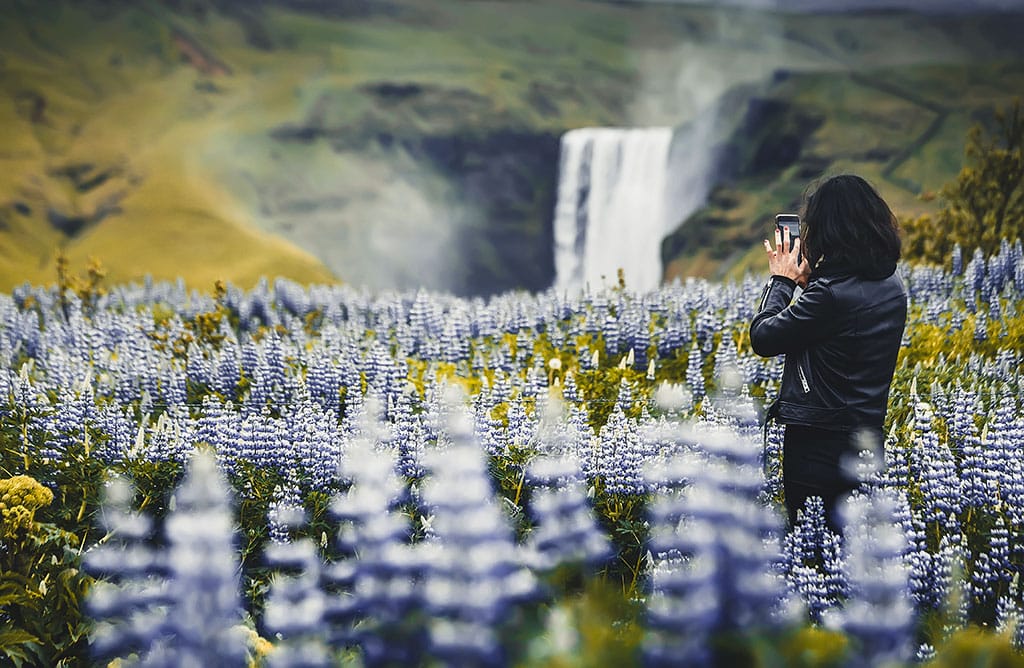
Public Transport
Public transport is rather limited in South Iceland, making it all but impossible to tour this part of the country using public buses. Buses usually only run one time a day (if that) around the countryside, and typically only stop at the main villages. From there, you would still need to find your own way to the actual attractions. Trying to discover South Iceland by public transport can be frustrating, time-consuming, and, if you need to take taxis to bridge the gaps between bus routes, costly.

Guided Tours
If you don’t want to drive yourself around South Iceland, guided tours would be the best way to explore this part of the island. Tours can be competitive cost-wise when compared with public buses, and on occasions can actually work out a bit cheaper. They are also much more time-efficient. Guided tours stop at the most popular places in the area and you’ll have the benefit of an English-speaking guide to share information and inside knowledge.
There are plenty of tours to choose between. As the most-visited area in the whole of Iceland, there’s a wide choice of tours that cover diverse attractions and include a variety of activities. You can book day trips from Reykjavik to places like Vik and Southeast Iceland’s marvelous Jokulsarlon Glacier Lagoon.
The tour to Vik lasts for 10 to 12 hours, with many stops en route. The longer tour to Jokulsarlon Glacier Lagoon takes around 14 to 15 hours. You can also arrange multi-day tours covering two or three days to allow you to experience more and at a less hectic pace. Many tours offer add-on activities, for example sailing access glacial lagoons, wildlife watching, and energetic hikes across glaciers.
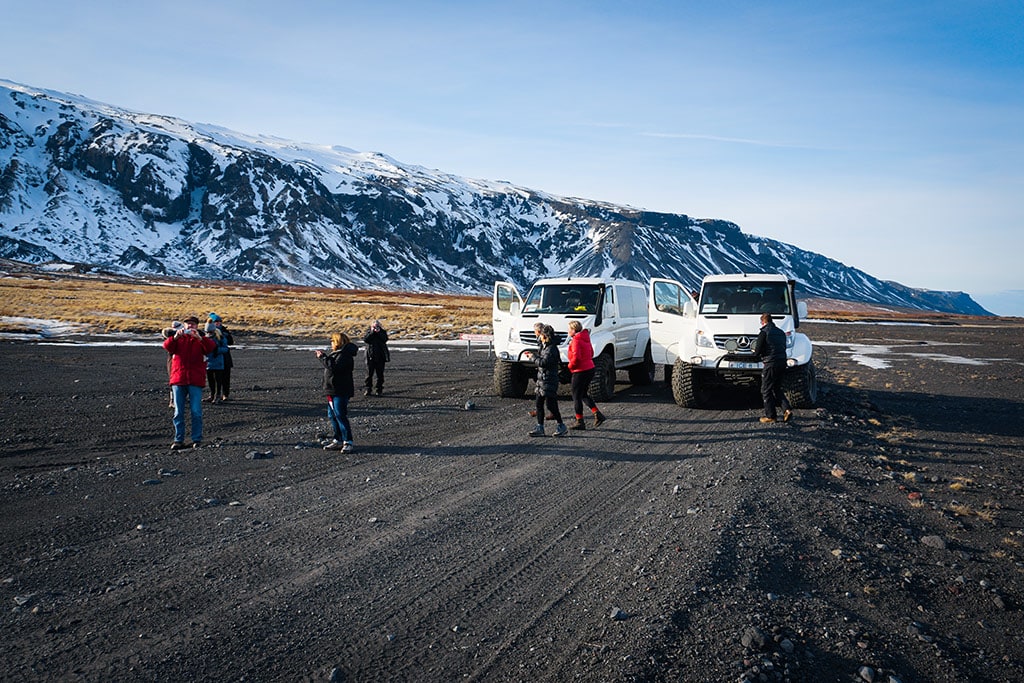
Self-Drive Tours
It’s certainly not difficult to drive yourself around South Iceland. However, the legwork of finding all relevant information, planning the route and stops, and creating the perfect itinerary may seem a little daunting. This information should help you out when it comes to planning a memorable trip to Iceland.
Plan to spend between 2 and 4 days exploring South Iceland on a self-driven trip. You’ll be able to visit all the major places detailed below. Naturally, though, if you can spend longer in the area, all the better. You can make even more stops, spend longer at each place, and feel as though you’ve really gotten to know this gorgeous part of the country.
With more time, you can also enjoy a variety of activities and guided excursions when you arrive in different destinations. Depending on your interest you may consider adding on experiences like horse riding along Black Sand Beach and guided hikes through the landscapes of Landmannalaugar or Thorsmork. Other popular options include guided hikes across glaciers, departing from Vik or Skaftafell. Pop into local visitor centers or tourist advice offices for more information. Alternatively, many hotels and guesthouses can make great recommendations too.

30 Must-see Attractions and Places on the South Coast of Iceland
Iceland’s beautiful South Coast attracts as many visitors as the famous Golden Circle. There are numerous fascinating and stunning places along the stretching coastline. The roads lead close to craggy mountains, otherworldly lava fields, charming villages, and rural farms. You’ll be able to see a number of volcanoes from the road too, including Katla, Hekla, and the notorious Eyjajfjallajökull. There’s certainly plenty to marvel at on any road trip. These are some of the major attractions you can look forward to visiting on a trip along the South Coast of Iceland, listed in order according to their distance from Reykjavik.
1. Heiðmörk Nature Reserve
Lying just a few kilometers outside the Icelandic capital, you can reach Heiðmörk Nature Reserve within just a short drive. You’ll spot the distinct volcanic red hills—known as Rauðhólar—in the distance as you approach, their strange shapes catching the eye.
Explore the caves of Mariuhellar, and go hiking, cycling, and horse riding through glorious terrain. The spectacular nature reserve is home to a scenic forest of more than 5 million trees. That’s definitely a sight to behold! The trees were planted in the 1950s by volunteers and pioneers.

2. Hellisheiði Geothermal Power Plant and Exhibition
The massive Hellisheiði (sometimes written as Hellisheidi) is the world’s third biggest geothermal power station. The sprawling site is responsible for providing almost a third of the total hot water and electricity for all of Iceland, harnessing the geothermal activity that is constantly occurring deep in the ground below. As the European and North American tectonic plates shift, the plant can create electricity. The modern power plant operates according to sustainable principles.
You can learn more about renewable and green energy sources and uses at the power station’s exhibition about energy. There’s also lots of information about global areas where geothermal activity takes place. The interesting and informative multimedia displays help to capture the attention. Many visitors go to Hellisheiði as part of jeep or mountain biking tours.
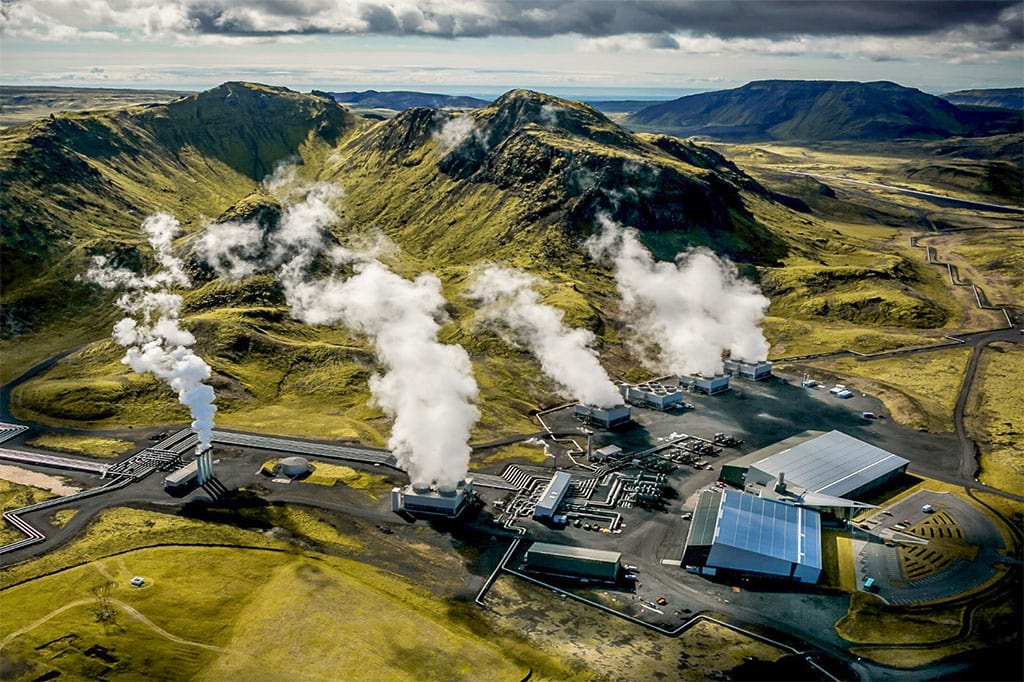
3. Hveragerði Geothermal Park
Hveragerði is a small town located 46.5 km (29 miles) outside of the capital. People initially moved here because of the large amounts of geothermal activity in the area. Open every day over the summer months, you can bathe in the hot springs and rejuvenate tired feet in the natural clay mud foot bath. See the geothermal oven where locals bake the well-known black bread underground. You can explore the surroundings by foot and on horseback.

4. Reykjadalur Valley – Hot Springs & Thermal River
Continue just a few kilometers from Hveragerði and you’ll come to the Reykjadalur valley. Nestled in the Hengill Mountains, Reykjadalur is nicknamed the Smoky Valley. It’s an active geothermal area with hot springs and an enticingly warm river. Walk along the steamy river and you’ll find wooden walkways and nooks where you can change, ready for a relaxing dip. The walk can be a bit more difficult in the winter, though in summer it’s a fairly easy hike. There aren’t any changing rooms or bathrooms, but that simply adds to the enchanting remote feel. The higher you walk, the hotter the water becomes. Check the water temperature—you don’t want it to be too hot or too cold—and then plunge in! The views are great too and, on a clear day, you can see all the way to the ocean.

5. Seljalandsfoss Waterfall
Visiting the waterfall of Seljalandsfoss is often a highlight when exploring Iceland’s South Coast. Located in the shadow of the mighty Eyjafjallajökull, water flows down from the volcano to feed the waterfall. A path leads right behind the cascade if you want a bit more adventure and the chance to see the falls from a different perspective. Do note that the path is often slippery and icy in the winter and so may not be accessible at this time of year.

6. Gljúfrabúi the “Secret” Waterfall
Nearby you can visit the secluded waterfall of Gljúfrabúi. Just a short stroll from Seljalandsfoss, the pretty Gljúfrabú flows through a crack in the rocks. You may need to walk through water and scramble over some rocks to reach the gorgeous cascade and you will almost certainly get wet.

7. Eyjafjallajökull Glacier-Volcano
Continue east along the South Coast, around 152 km (94 miles) from Reykjavik and on the other side of the Markarfljót glacial river, and you’ll come to the awe-inspiring Eyafjallajökull volcano. Standing more than 1,650 meters (5,400 feet) tall, the volcano became known around the world when, in the year 2010, its savage eruption led to a gigantic ash cloud that wreaked havoc on air travel. Many flights were grounded and lots of people were stranded overseas. The towering volcano is covered with a sheet of ice and makes for a formidable sight.
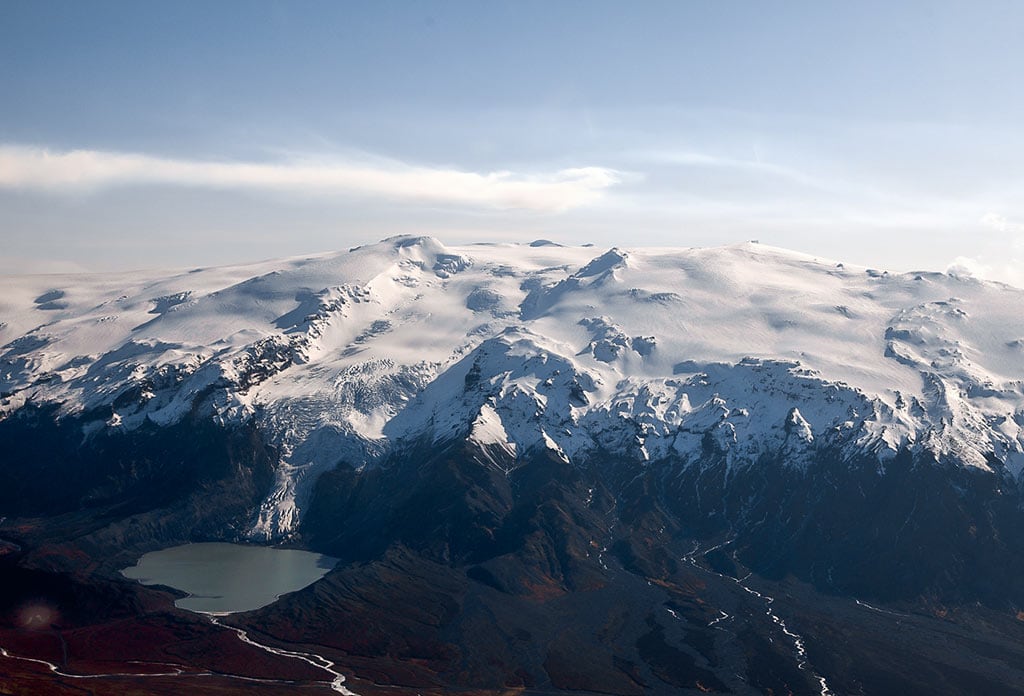
8. Skógafoss Waterfall
In a land known for its striking natural beauty, being known as one of the country’s most stunning waterfalls is an accolade that Skógafoss Waterfall can be proud of. Spanning 24 meters (78 feet) and cascading down soaring cliffs that are 18 stories high, the waterfall rally is a breath-taking sight. Hear the thundering roar as the spray splashes your face as you stand near the bottom of the falls, and then climb to the top to admire the falls from a different angle. Don’t be alarmed if you have a sense of deja vu as you explore—the waterfall has featured in several movies and TV shows, including the popular Game of Thrones and Vikings.
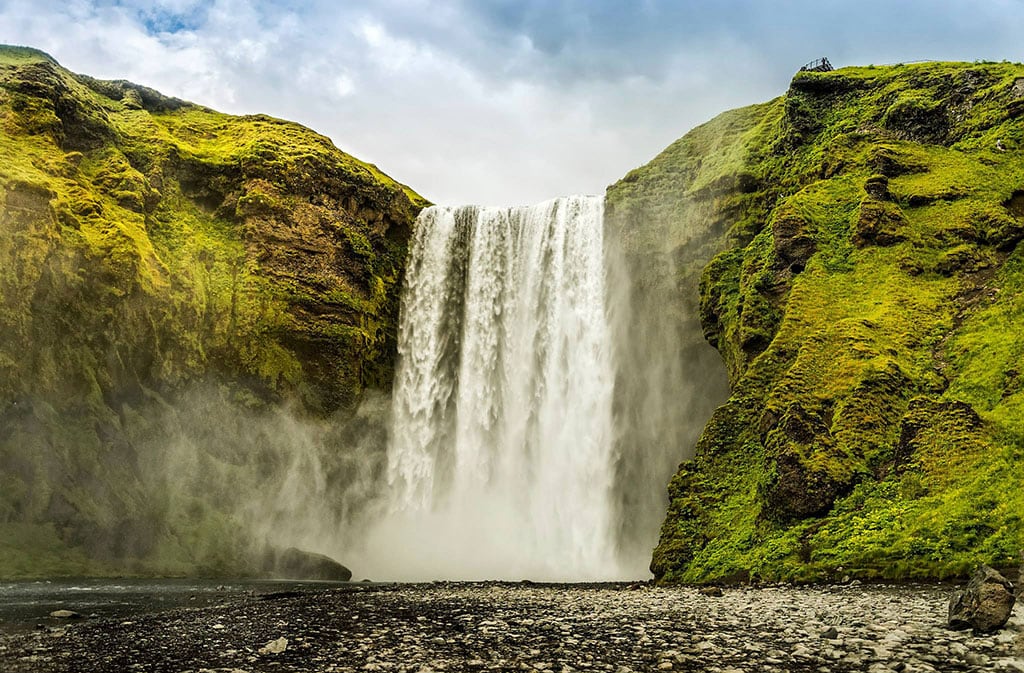
9. Skógar Museum
Local lore tells of a treasure chest that was hidden behind the falls in the 10th century. Placed there by a Viking, the chest stayed hidden behind the waterfall for hundreds of years. Legends say that one day, someone spotted the bounty and made a grab for it. They were only able to get a golden ring, which was attached on the outside of the chest, before the jewel-filled box vanished. This gleaming ring is now on display at the Skógar Museum, with many people believing the ring adds authenticity to the tale. The museum is also home to cultural items, folk displays, and artifacts related to Iceland’s history and heritage.

10. Kvernufoss Waterfall
Walk to the east of Skógafoss Waterfall to reach the lesser-visited watery gem that is Kvernufoss Waterfall. Beautiful in its own right, it’s made all the more appealing by the fact that it sees relatively few tourist crowds. Many tours don’t stop here and there isn’t much tourist information about the cascades. If you’re looking to enjoy a marvelous South Coast attraction in peace and quiet, this could be just the spot for you!
Water tumbles around 40 meters (131 feet) down the rocks, and it lies mostly hidden in a scenic gorge. A pathway leads behind the waterfall, though this is only accessible in the summer months.

11. Seljavallalaug Pool
Around 152 km (94 miles) from the Icelandic capital, Seljavallalaug Pool is among the oldest artificial pools in the nation. The man-made outdoor swimming pool dates back to 1923. Picturesque hills surround the scenic valley, meaning you can enjoy glorious views as you swim. The water remains around 30–35°C (86–95°F), making it pleasant enough for an active swim, but it’s probably too cold for relaxing in the water.
There’s a small cabin for changing if you fancy a dip, though there aren’t any bathrooms or rubbish bins. Be responsible and take all your trash away with you. It’s a fabulous stop for budget travellers as there’s zero fee to enjoy the outside swimming pool.

12. DC-3 Plane Wreck on Solheimasandur Beach
Follow the hour-long walk to Solheimasandur Beach to discover one of the more unusual sights in South Iceland: an abandoned naval plane. The sight is rather eerie, with the wreckage lying on the black sands of an isolated beach. Despite its remote location, many visitors make the trip, with plenty of footage on social media to pique the curiosity of future travellers.
The plane is a Douglas DC-3 and was once used by the US Navy. In November 1973, it crash-landed in the same spot where it remains today. All of the 7 crew members miraculously survived, although most report having thought that they were close to death. Nobody really knows what happened on that ill-fated day. Some accounts put the crash down to mechanical failure, while others say that the pilot used the incorrect fuel tank and so the plane ran out of gas. There were no attempts to recover the aeroplane, and it will likely stay in its present position until time and the weather take their toll.

13. Dyrhólaey Stone Arch
South Iceland’s Dyrhólaey Peninsula boasts an almost 400-foot (120-metre) promenade from which you can soak up gorgeous panoramic views of the coast. Fun fact: Dyrhólaey means Door Hill Island. The area is known for its wide array of bird life, particularly in the summer. Look out for various Arctic marine birds and observe thousands of cute Atlantic puffins. Take plenty of pictures of the stone archway, also called Dyrhólaey, and the quaint historic lighthouse.

14. Reynisfjara Black Sand Beach
Reynisfjara Black Sand Beach is incredibly well known. Indeed, it’s among the most-visited destinations in all of Iceland. The stunning natural beauty is the reason why the esteemed National Geographic named Reynisfjara as one of the top-ten most beautiful non-tropical beaches on the planet!
You’re sure to be enchanted by the striking black sands, incredible sea stacks, soaring cliffs, eye-catching rock formations, and secluded caverns. Many puffins inhabit the craggy rocks over the summer (between May and August). Don’t miss the 49-foot-tall (15-metre-tall) Reynisdrangar, a basalt rock stack that rises from the swirling ocean waters. Local legends say that the rock is the frozen remains of three trolls, solidified in the sunshine while trying to pull a boat out of the waves.
Do be careful and keep your guard up while visiting Reynisfjara. Always pay attention to warning signs and don’t get too close to the coast. Unpredictable waves often hit the shores and have caused a great number of accidents in the past. Known as Sleeper, Sneaker, or Rogue Waves, the powerful fast-flowing waves are strong enough to knock you over and drag you out to sea. The icy waters coupled with the overpowering currents can be fatal.
15. Vík Village
Often abbreviated to simply Vík, Vík í Mýrdal is a charming small town 187 km (116 miles) from Reykjavik. It’s an important hub in South Iceland, with diverse options for sleeping, eating, and shopping, as well as other tourist services. Head up the hill to visit the quaint church and soak up the brilliant views over the town. Stroll along the black sand beach and admire the terrific vistas of Reynisdrangar.

16. Hjörleifshöfði & Yoda Cave
Hjörleifshöfði is a historic cape on the plain of Mýrdalssandur. A top spot for anyone who loves geology, you can step inside Hjorleifshofdi Cave, a recently discovered chamber with an unusual shape.
Nicknamed the Yoda Cave, the cavern does bear a striking resemblance to the well-known Star Wars’ character. The cave also owes the Star Wars franchise for its fame—it was pretty unknown until it featured in Star Wars Rogue One.

17. Fjaðrárgljúfur Canyon
Close to Southeast Iceland’s village of Kirkjubæjarklaustur, and 261 km (162 miles) from the capital, Fjaðrárgljúfur Canyon is a stunning vision of natural beauty. The gaping chasm reaches some 100 meters (328 feet) deep into the ground and has walls that snake for more than 2 kilometers (1.2 miles). There’s a babbling river that winds its way to the sea and there are moss-covered jutting rocks and grassy patches. The overall visual effect is like something you may expect in the pages of a fantasy book.
If you’re a “Belieber” (or just a general fan of pop music) you may recognize the area from Justin Bieber’s music video for “I’ll Show You”. The canyon’s popularity has rocketed since Bieber’s video, with some 60–80% more visitors to the canyon since the music video came out.
18. Eldhraun Lava Field
While there are many sublime places along Iceland’s Ring Road, Eldhraun Lava Field is one of the most unusually striking. Vibrant green moss covers stark black lava rocks, stretching across an ethereal field. The rugged rocks have something of an air of softness, thanks to the mossy blanket. The lava field is one of the biggest such areas in the world, covering 565 square kilometres (218 square miles). The area has one of Iceland’s most impressive lava tube systems too, with more than 200 caves lying just north of Lake Laufbalavatn.
The spectacular lava field was born during one of the planet’s largest recorded volcanic eruptions. The mighty eruption lasted for a year, from 1783 to 1784. It was named the Skaftáreldar—The Skaftá River Fires—and it caused devastation across the country and farther afield. In Iceland, it caused disasters, disease, crop failures, and food shortages. The clouds of ash caused lots of smog and haze in Britain, with the summer having been named the Sand-Summer. It is thought that darker days, caused by ash blocking out sunlight, may have been a contributing factor towards the discontent that led to the French Revolution.

19. Kirkjugólf – The Church Floor
En route to Stjórnarfoss Waterfall, Kirkjugólfið is a protected national monument in the town of Kirkjubæjarklaustur. It’s a striking rock formation that comprises basalt columns spread over around 80 square metres (861 square feet).
Translated into English, the name Kirkjugólfið means The Church Floor. It takes its name from the fact that it was once thought to be the floor of an old church. It certainly does look like it was purposely created. Investigations have shown, however, that there was never any building at the site. Instead, the magnificent formation was made by nature’s forces, with lava cooling and cracking.
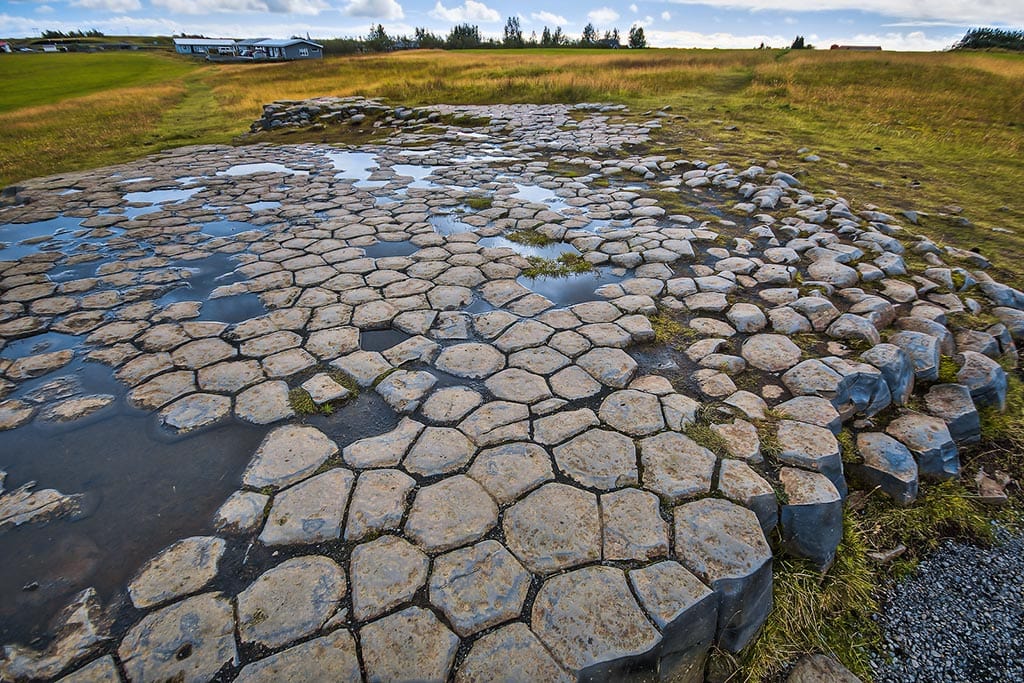
20. Foss á Síðu Waterfall
Located around 10 kilometers (6.2 miles) from Kirkjubæjarklaustur, Foss á Síðu is another of South Iceland’s cascading treasures. It may not be the country’s biggest waterfall, but it’s still, nonetheless, beautiful. It is renowned for its awesome views and amazing photo opportunities. You’ll spot the white water flowing down the dark rocks from the distance and, as you get closer, the tumbling water surrounded by steep cliffs and hills is definitely a magical sight.

21. Dverghamrar (Dwarf Rocks)
Continue a little further from Foss á Síðu Waterfall to reach Dverghamrar, another protected natural monument in South Iceland. A short path leads from the carpark down to the rock formations. The name means Dwarf Rocks in English; it was called this because of local legends that say mystical beings like elves and dwarfs live around the basalt columns.

22. Lómagnúpur
The gigantic Lómagnúpur looms large on the horizon, standing at a whopping 764 meters (2,507 feet) tall. If the weather is good, you can see the towering rock from up to 30 kilometers (18.6 miles) away in Skaftafell National Park (further along the South Iceland route). You really can’t miss seeing it as you drive along the main road.
Many visitors overlook making a stop here, pressing on to reach more famous destinations. If you do add this to your plans, however, you won’t be disappointed. There will be few tourists to break the peace and you can enjoy the brooding views over the landscapes, which change frequently according to the weather conditions.

23. Skaftafell Nature Reserve
Skaftafell was once its own national park until it was merged with Vatnajökul National Park. A top place for hiking, you can lace up your boots to set out along some of the well-marked and well-maintained trails. There are walking paths of varying lengths and for all levels of hiker.
Hike to picture-perfect viewpoints to gaze in awe across the magnificent glacier. You can also wander through verdant forests filled with birch trees, appreciate raw nature at its best, and explore bare glacial valleys. The smaller glaciers offer a wealth of exciting adventures too. Try year-round activities like glacier hikes, ice climbing, and ice caving, all under the watchful eye of an experienced and professional guide.

24.Svartifoss Waterfall
Walk a short way into Skaftafell National Park to be rewarded with picturesque views of the well-known Svartifoss Waterfall (Black Falls). The cascades drop 20 meters (80 feet) over a cliff and are surrounded by hexagon-shaped black basalt columns. The attractive falls are fed with icy meltwater from the Svínafellsjökull Glacier.
The striking geological formations around Svartifoss have provided the inspiration for countless artists, poets, and architects across the years. For example, the unique Hallgrímskirkja in Reykjavik used inspiration from the columns at Svartifoss (along with Thor’s hammer) in its creative design.

25. Svínafellsjökull Glacier
Part of the stunning Skaftafell Nature Reserve, Svínafellsjökull Glacier is a glacial branch of the mighty Vatnajökull Glacier. Vatnajökull Glacier isn’t only the biggest glacier in Iceland; it’s the largest in all of Europe too. Listen for the eerie cracking sounds of the glacier as you explore, and marvel at the breathtaking beauty. It truly is a place that must be seen to be believed. It’s probably little surprise that it was used in the hit production, Game of Thrones.
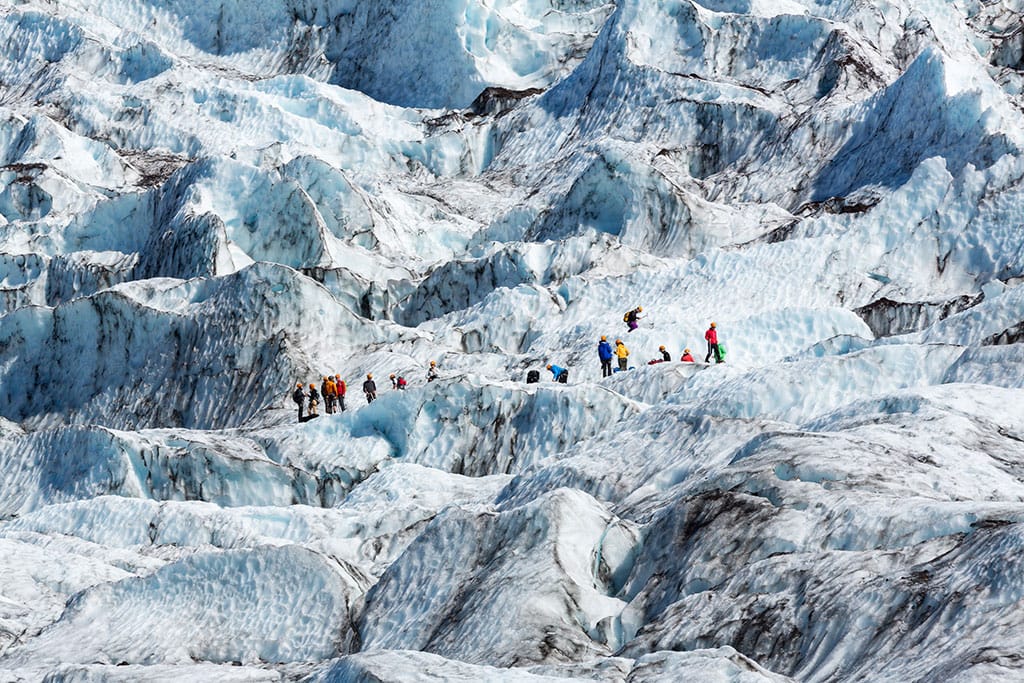
26. Hofskirkja Turf Church
Situated 342 kilometers (213 miles) from Reykjavik in South East Iceland, the fascinating Hofskirkja Church can be found in the region of Öræfi. It’s one of only 6 remaining turf churches in the country, with a layer of grass sitting on top of the place of worship. Burial grounds lie beneath the grassy covering. Constructed according to traditional turf designs, Hofskirkja Church is one of the oldest such churches in Iceland.

27. Vatnajökull Glacier
Vatnajökull Glacier covers an impressive 8,100 square kilometers (3,127 square miles). It’s the world’s biggest ice cap away from the poles and boasts an area that is three times larger than Luxembourg! Shielded and hidden by the huge lump of ice is Iceland’s tallest mountain. Standing a total of 2,110 meters (6923 feet) tall, this towering mountain is called Hvannadalshnúkur. Around the glacier, there are more mountains and volcanoes—some of which are still active—along with underground lakes, yawning chasms, and rugged valleys.
If that wasn’t impressive enough, Vatnajökull is the source of more than 30 outlet glaciers, with shimmering lagoons, sparkling waterfalls, dark ice caves, and raging rivers. You can spot many of these smaller glaciers, along with other exciting natural features, through the window while driving down Road 1.

28. Fjallsárlón Glacier Lagoon
Sitting at the southern end of Vatnajökull Glacier, Fjallsárlón is a beautiful iceberg lagoon. Relatively small in size, you can approach quite close to the ice cap and enjoy the views of the edge. The lagoon doesn’t meet the sea, and so the icebergs stay put for quite a long time. Peaceful and pretty, it’s a terrific place to enjoy a relaxing stay surrounded by Mother Nature’s handiwork.

29. Jökulsárlón Glacier Lagoon
Located close to Route 1 and handy to access, the large Jökulsárlón is the most famous glacier lagoon in Iceland. Sitting almost midway between Skaftafell Nature Reserve and Höfn, it’s a popular attraction for people exploring Iceland’s Ring Road or South Coast.
The lagoon is filled with meltwater from the enormous Vatnajökull. Icebergs break from the glacier and bob in the lagoon too, with huge pieces of rocks that can tower over the landscapes. The icebergs eventually cross the lake to wash up on the edges or float out to the ocean.
The sublime landscapes of Jökulsárlón Glacier Lagoon have been chosen to appear in a number of hit movies, including a couple of high-action James Bond films (Die Another Day and A View to Kill), Batman Begins, and Lara Croft: Tomb Raider.

30. Diamond Beach
Diamond Beach lies 378 kilometres (235 miles) from Iceland’s capital city. The beach is close to Jökulsárlón Glacier Lagoon, and is part of the greater Breiðamerkursandur glacial plain. The black sands contrast with the deep blues of the ocean. Further contrast is created by the icy whites of the icebergs that land here from the lagoon via Jökulsá River. The beach takes its name from the dazzling icebergs glinting in the sunshine, rather like diamonds, against the black grainy sands.
Numerous seals bask along the shore and the beach is a prime viewing spot for graceful orcas. It’s a fabulous destination for both landscape photographers and lovers of wildlife.
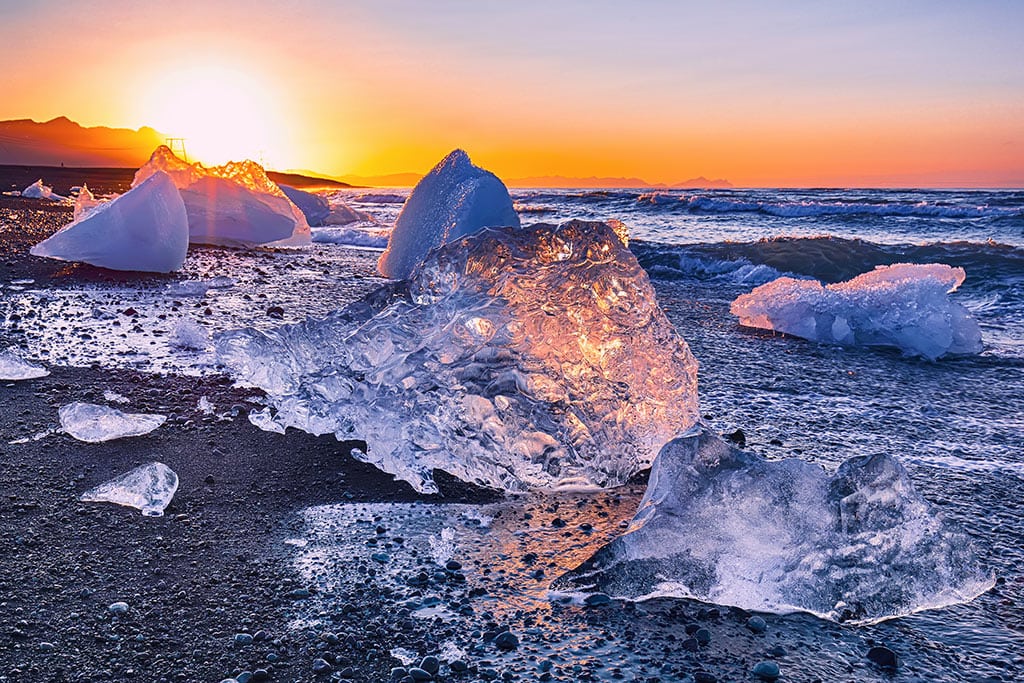
Which of these amazing spots would you love to visit for your holiday?
Get in touch with our travel experts to start planning your tailor-made vacation in Iceland.




